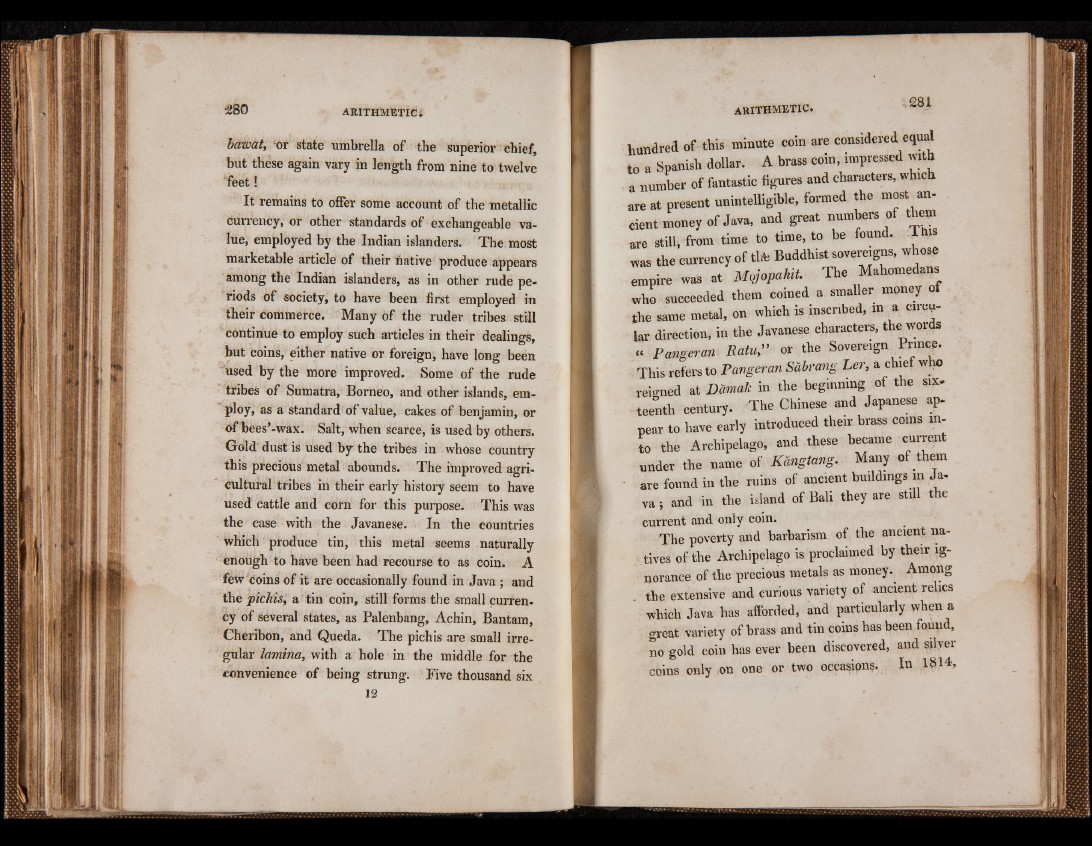
280 a r it h m e t ic *.
bawat, -or state umbrella of the superior chief,
but these again vary in length from nine to twelve
f e e t!
It remains to offer some account of the metallic
currency, or other standards of exchangeable value,
employed by the Indian islanders. The most
marketable article of their native produce appears
among the Indian islanders, as in other rude periods
of society, to have been first employed in
their Commerce. Many of the ruder tribes still
continue to employ such articles in their dealings,
but coins, either native or foreign, have long been
'used by the more improved. Some of the rude
tribes of Sumatra, Borneo, and other islands, employ,
as a standard of value, cakes of benjamin, or
of bees’-wax. Salt, when scarce, is used by others.
Gold dust is used by the tribes in whose country
this precious metal abounds. The improved agricultural
tribes in their early history seem to have
used cattle and corn for this purpose. This was
the case with the Javanese. In the countries
which produce tin, this metal seems naturally
enough to have been had recourse to as coin. A
few coins of it are occasionally found in Java ; and
the pichiSy a tin coin, still forms the small currency
of several states, as Palenbang, Achin, Bantam,
Cheribon, and Queda. The pichis are small irregular
lamina, with a hole in the middle for the
convenience of being strung. Five thousand six
12
a r it h m e t ic .
hundred of this minute coin are considered equal
t„ a Spanish dollar. A brass coin, impressed with
a number of fantastic figures and characters, which
are at present unintelligible, formed the most ancient
money of Java, and great numbers of them
are still, from time to time, to be found. T
was the currency of Buddhist sovereigns, whose
empire was at Mojopahit. The Mahomedans
who succeeded them coined a smaller money of
the same metal, on which is inscribed, in a circular
direction, in the Javanese characters, the words
« Pangeran Ratu,” or the Sovereign Prince.
This refers to Pangeran Sabrang her, a chief who
reigned at Damak in the beginning of the sixteenth
century. The Chinese and Japanese ap-
pear to have early introduced their brass coins into
the Archipelago, and these became current
under the name of Kdngiang. Many of them
a r e found in th e ruins o f ancient buildings in Java
*, and in th e island o f B a li they are still the
current and only coin.
The poverty and barbarism of the ancient natives
of the Archipelago is proclaimed by their ignorance
of the precious metals as money. Among
the extensive and curious variety of ancient relics
which Java has afforded, and particularly when a
great variety of brass and tin coins has been found,
no gold coin has ever been discovered, and silver
coins only on one or two occasions. In 1814,